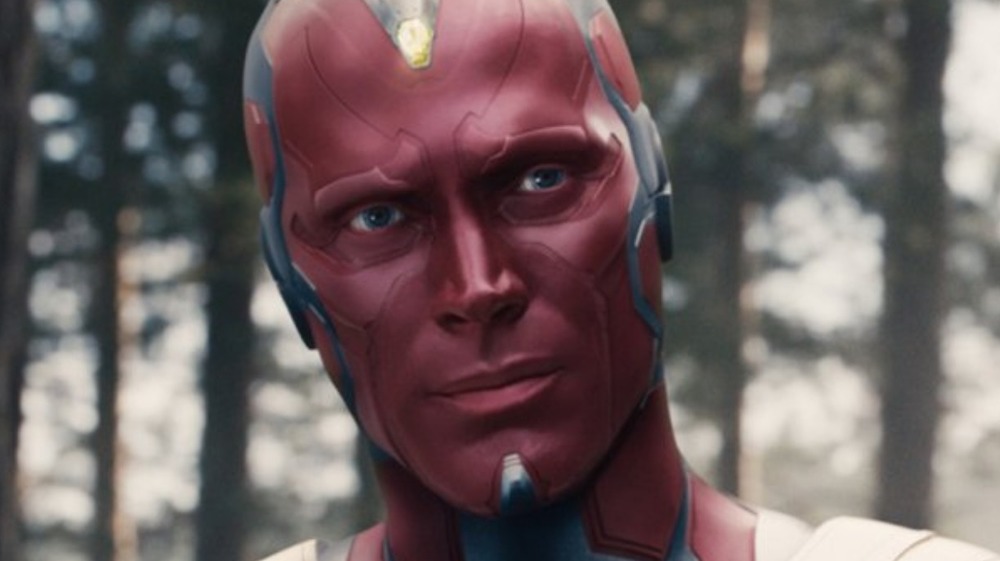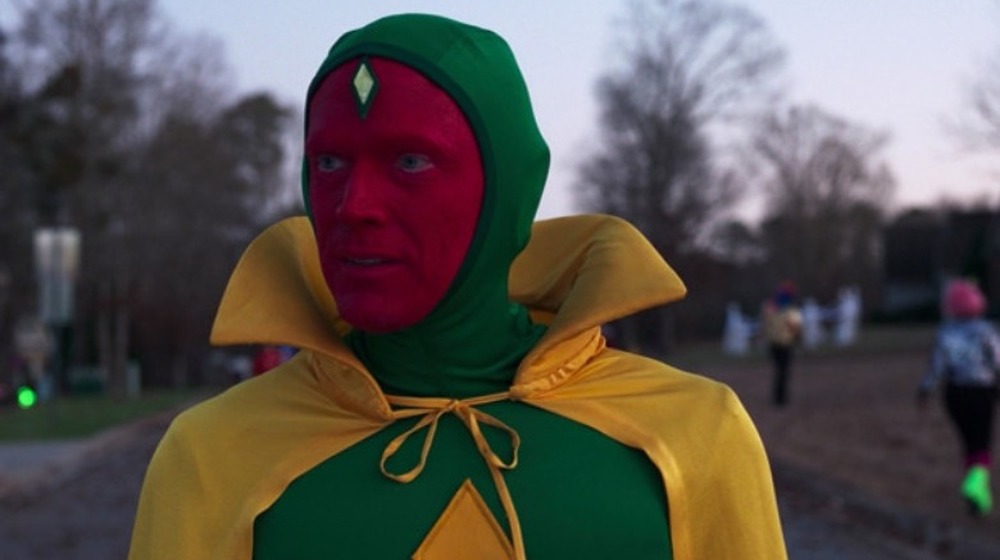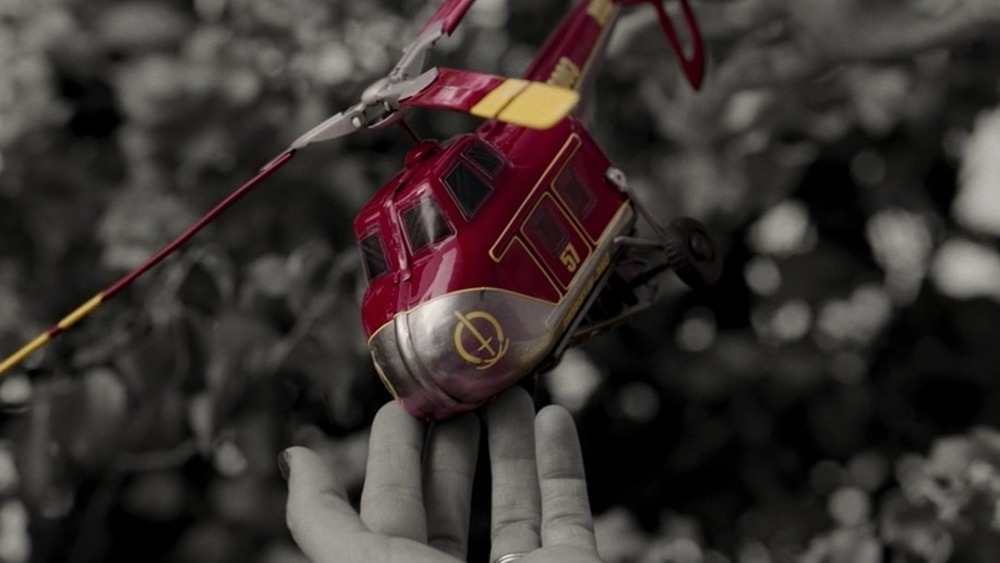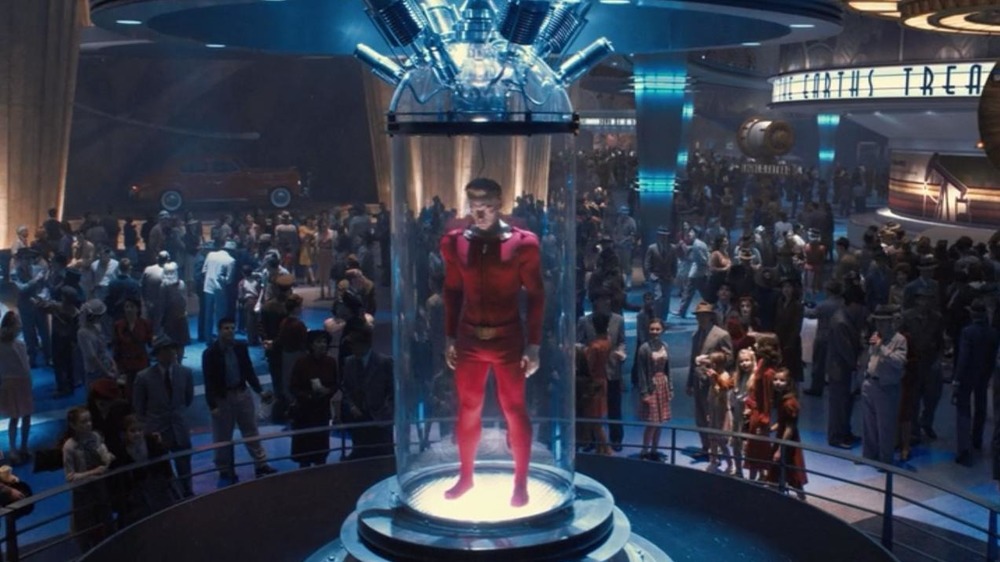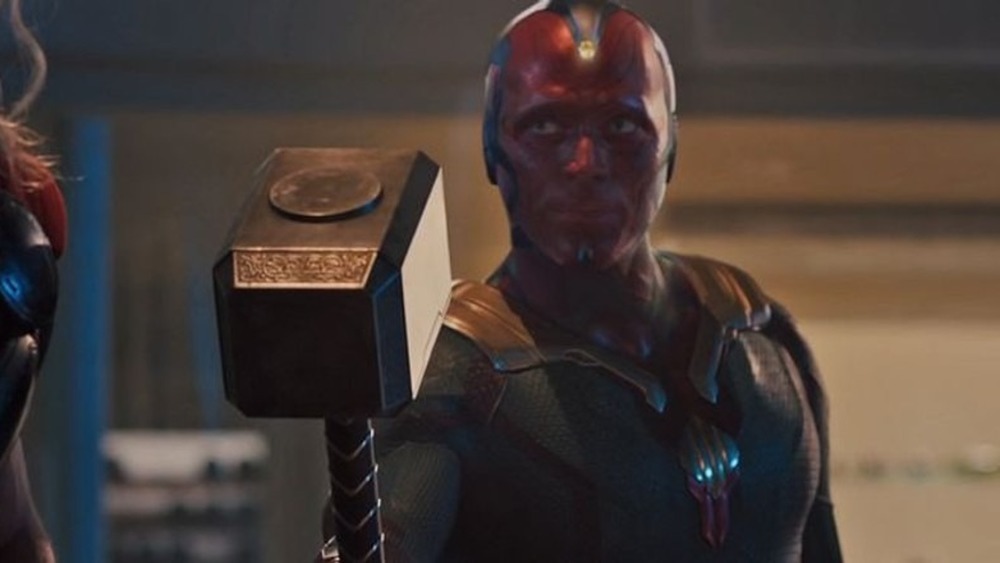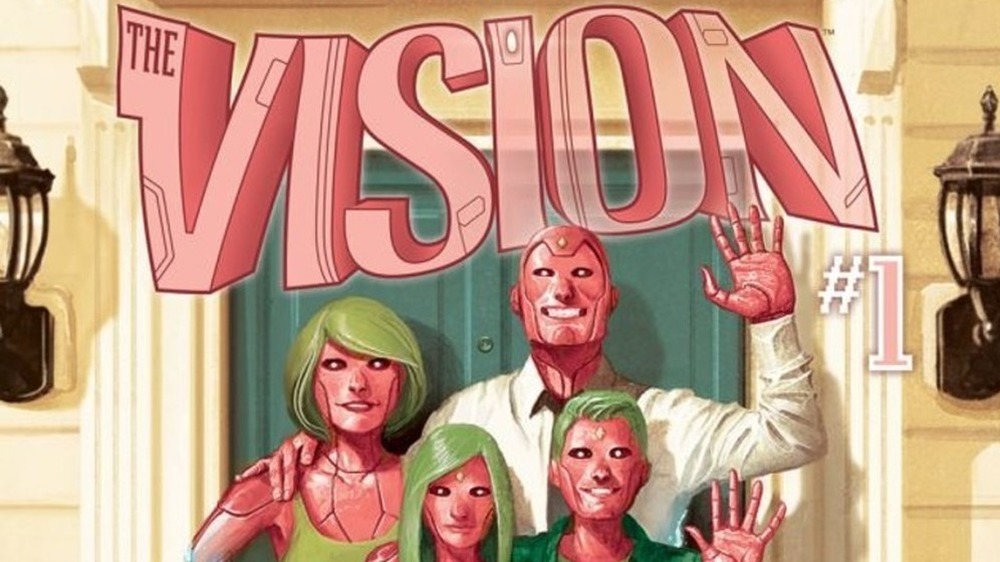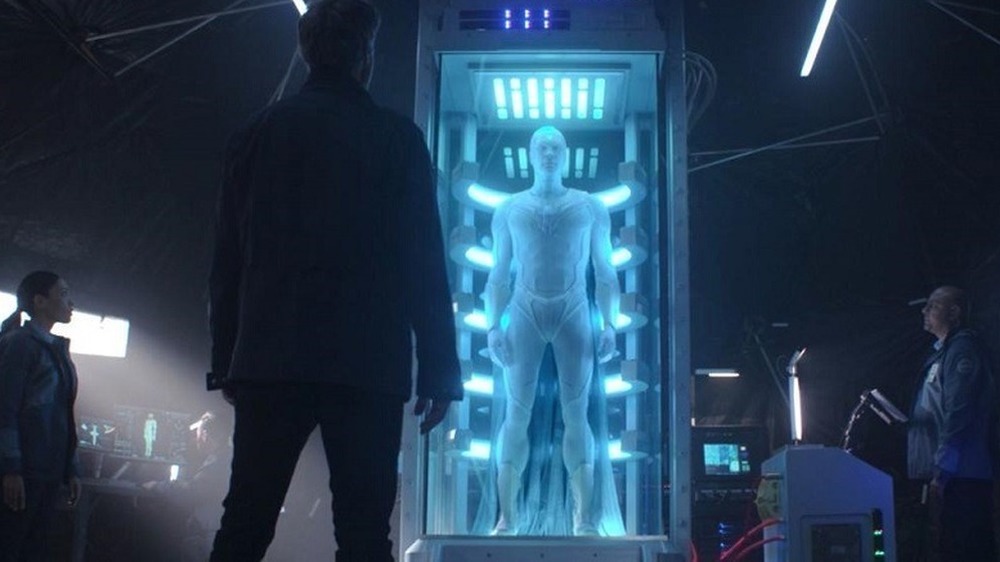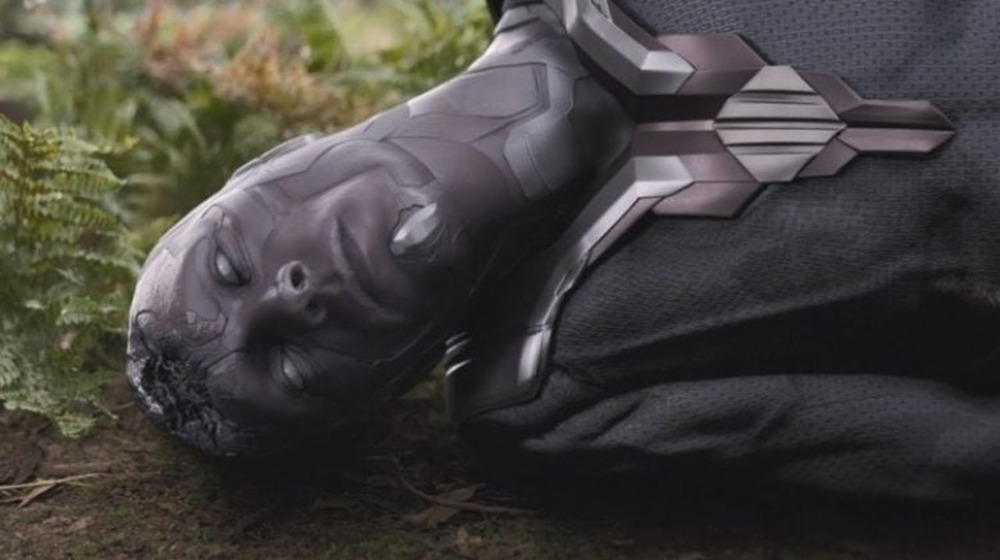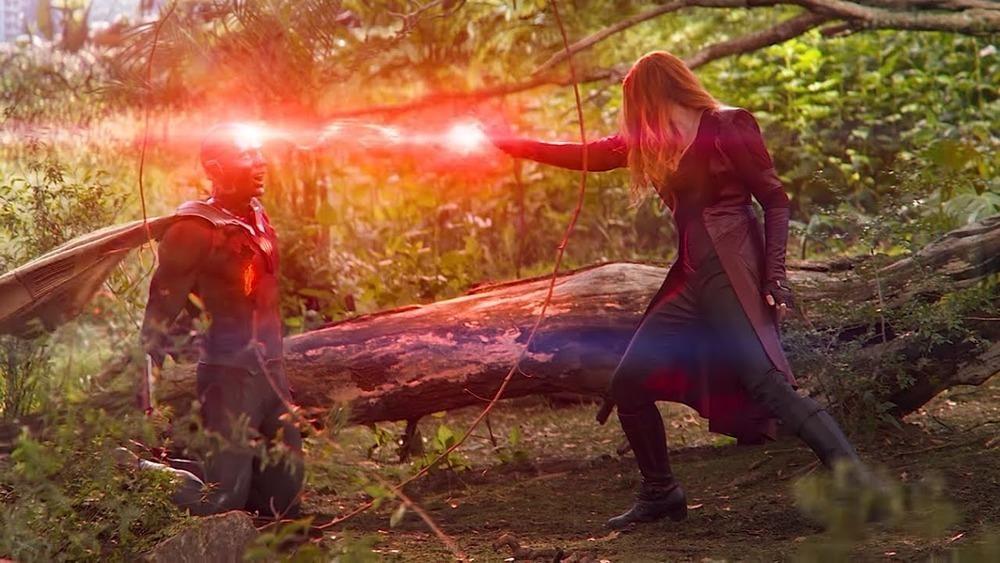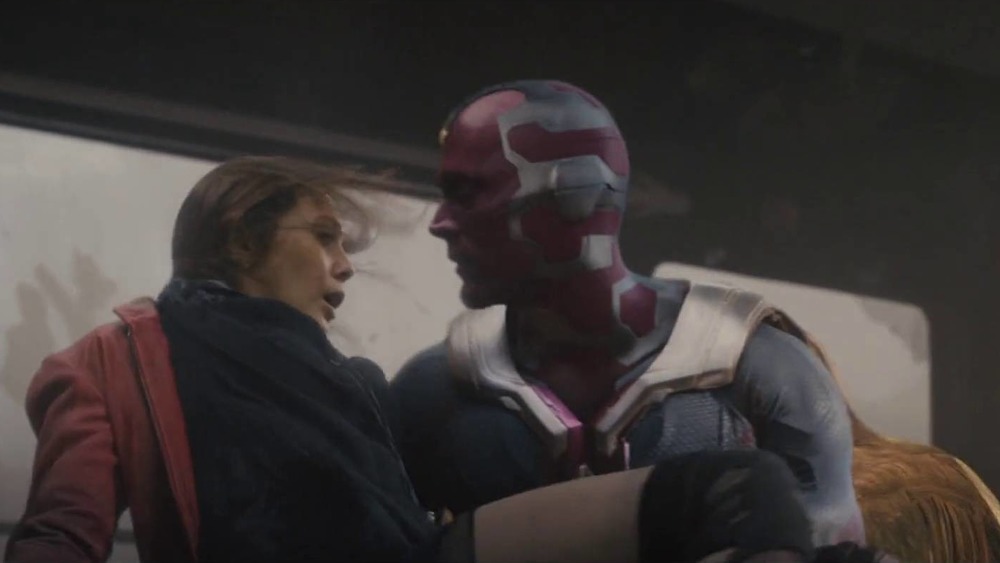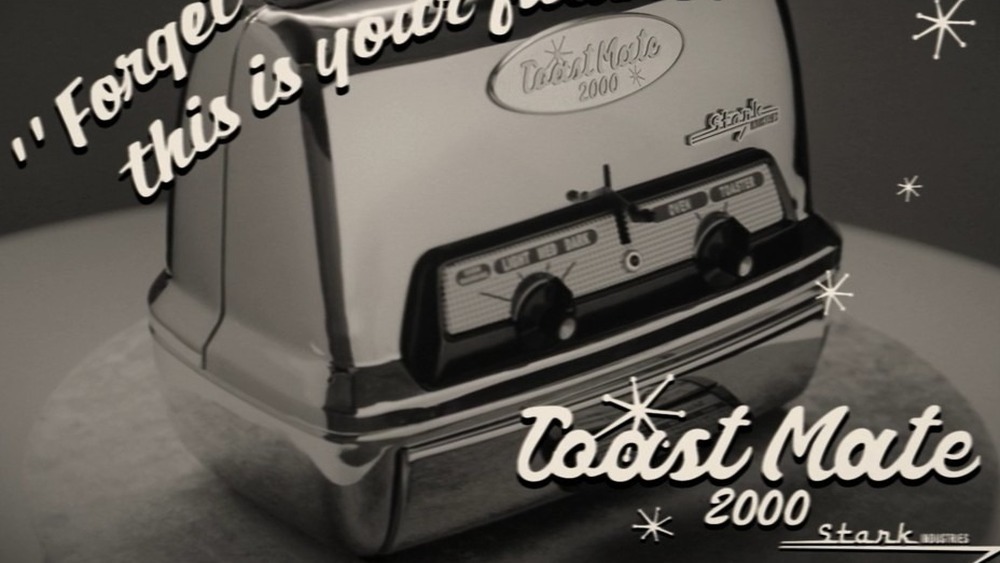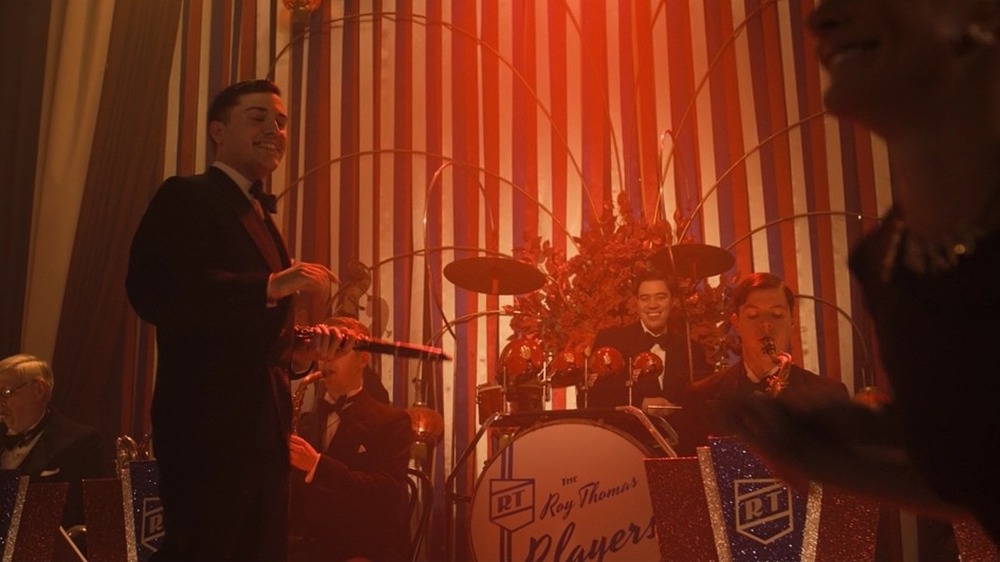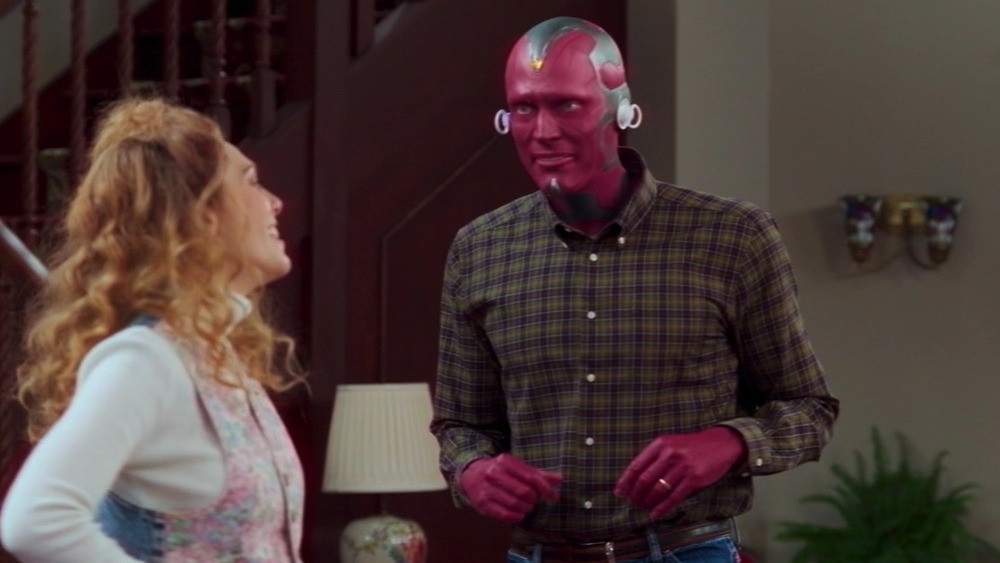The Best Vision Easter Eggs In The MCU
In the comics, the synthezoid Vision is one of the foundational Avengers. While he may not have been one of the group's founders (unlike most of the earlier team members), Vision is introduced in the Avengers comic before he's seen anywhere else — in 1968's Avengers #57, to be specific. Also, Vision is most closely associated with Earth's Mightiest Heroes rather than any solo adventures or any of Marvel's other superhero groups. In other words, as soon as fans knew there would be an Avengers movie, the possibility of a live-action version of Vision on the big screen was a tantalizing possibility.
The MCU's filmmakers knew about fan expectations, and they've been dropping Easter eggs about the synthezoid since the MCU's first phase. And these little in-jokes and references continue to this day with Easter eggs hidden in the Disney+ miniseries WandaVision. Seriously, throughout the entire Marvel Cinematic Universe, you can behold the Vision. From Halloween costumes to big band music, from Marvel's depiction of the early '40s to the post-Blip world of 2023, here are the best Vision Easter eggs you're going to find in the MCU.
(Warning — there are spoilers below.)
Vision's comic book Halloween costume is kind of perfect
Marvel Studios has a long tradition of simultaneously poking fun at their own characters and paying homage by giving us glimpses of those heroes in goofier yet more comic book-accurate versions of their costumes. Edward Norton's Bruce Banner passes on the purple pants Betty Ross (Liv Tyler) buys him in 2008's The Incredible Hulk, both Jessica Jones (Krysten Ritter) and Trish Walker (Rachael Taylor) are less than thrilled at the idea of their more comics-accurate attire in Netflix's Jessica Jones, and Luke Cage made its hero's science experiment garb into his '70s comic book outfit. Heck, in 2011's Captain America: The First Avenger, Steve Rogers (Chris Evans) wears a clownish, comics-accurate version of his costume before he gets one that isn't laughable.
It isn't until the "All-New Halloween Spooktacular!" episode of WandaVision that we get a similar treatment for Paul Bettany's Vision. Bowing to Wanda's (Elizabeth Olsen) wishes, Vision dresses for Halloween in a mostly green costume with a yellow diamond over his chest. He also wears a bright yellow cape with a prominent collar. A fake yellow diamond is attached to his forehead where the Mind Stone should be, and his face is painted bright red.
The false Pietro (Evan Peters) makes a number of guesses at what the costume is supposed to be, including comparing him to a traffic light, a half-shucked corn cob, and a booger. Vision finally agrees to the last one, presumably just so Pietro will shut up about it.
This WandaVision Easter egg reaches back to Vision's beginnings
One of the more interesting Vision Easter eggs we've seen comes in "Don't Touch That Dial," the second episode of WandaVision. Wanda is in her living room when she hears something crash outside. In her front yard, she finds what appears to be a remote control helicopter in the bushes. Later, in "We Interrupt This Program," we learn this is actually a S.W.O.R.D. drone transformed by the Hex.
The helicopter is one of the first things in color we see in WandaVision's black-and-white world. It's red and gold with some metallic silver mixed in — similar to the color scheme of Tony Stark's (Robert Downey Jr.) Iron Man armor. The number 57 is on its side, and the S.W.O.R.D. symbol is painted on the front.
How is this a Vision Easter egg? Well, the most obvious sign is the number 57 on the side of the helicopter, which matches the number for the comic in which Vision premieres — 1968's Avengers #57. It's also probably not a mistake that the sitcom most heavily referenced in WandaVision's second episode is Bewitched, which premiered in 1964 and was still going strong in 1968, when Vision's first appearance showed up on comic book spinners. Plus, the Iron Man colors reference Tony Stark — one of Vision's creators. It also arrives with what sounds like an accidental crash, and much of the rest of the episode involves Vision malfunctioning after swallowing a piece of chewing gum.
The first Captain America movie references a retconned origin story
We first meet Vision in 2015's Avengers: Age of Ultron. But in a sense, we kind of met him four years earlier in Captain America: The First Avenger. Before Steve Rogers goes through the experiment that makes him a super soldier, he visits the World's Fair where — among other things — he sees what appears to be an inert man in a red costume kept in a transparent tube. Above the man is a sign that reads, "Phineas Horton Presents the Synthetic Man." This is Jim Hammond, the original Human Torch.
Long before the introduction of the Fantastic Four, Marvel Comics had an earlier version of the Human Torch who was an android created by Dr. Phineas Horton. In fact, it's a battle between the original Human Torch and the Sub-Mariner that creates the concept of the Marvel Universe. When they meet and fight in 1940's Marvel Mystery Comics #8, it's the first time two of Marvel's heroes are shown to occupy the same narrative.
In 1975's Avengers #135, the Vision discovers that Ultron created him using the brainwave patterns of the hero Wonder Man and the body of Jim Hammond. In other words, what on the surface seems like just a Human Torch Easter egg in The First Avenger is also a Vision Easter egg. In fact, before the premiere of WandaVision, some fans were theorizing this might be the key to how Vision would be resurrected.
In WandaVision, Phil mentions Vision's worthiness
The second episode of WandaVision includes a fun callback to Vision's first scene in Avengers: Age of Ultron. Vision visits the Westview library in hopes of joining the local neighborhood watch. The other men eventually accept him, though Vision discovers the group is more concerned about eating Danishes and trading gossip than it is about community security. Herb (David Payton) tells the group about someone named Johnson, who's apparently been lying about building his son's treehouse. After the story, Phil Jones (David Lengel) adds, "That blockhead can't even swing a hammer."
This references the famous scene in Age of Ultron in which Vision — only a few minutes old at this point — shows he's one of the few people in the MCU capable of lifting Thor's (Chris Hemsworth) enchanted hammer, Mjolnir. Thor even lets the synthezoid borrow the weapon in the final battle against Ultron (James Spader) and his armies of robots.
Vision's ability to lift Mjolnir may not have anything to do with his worthiness, by the way. In 1981's Thor #305, one of Galactus' lesser-known heralds — Gabriel the Air-Walker — is able to wield Mjolnir. This is because Gabriel is an android, and the hammer's enchantment doesn't recognize him as life. As far as the enchantment is concerned, an android lifting Mjolnir is no different from Thor hanging the weapon from a coat rack in 2013's Thor: The Dark World.
The concept of WandaVision borrows from this 2016 series
As soon as fans started catching glimpses of images from WandaVision, it was obvious that the miniseries was taking part of its inspiration from an acclaimed, fan-favorite comic — 2016's The Vision by Tom King and Gabriel Hernandez Walta. In The Vision, the eponymous synthezoid builds himself an entire family of synthetics, all with names — like his own — beginning with "V." There's his wife, Virginia, as well as his two kids, Viv and Vin. With the family he builds from scratch, Vision tries to live an idyllic existence in a quiet suburb, but it isn't meant to be.
They even eventually have their own synthezoid dog named Sparky, built from the brain of a dog who accidentally electrocutes itself while unearthing the corpse of a dead supervillain in Vision's backyard. Just as WandaVision's Sparky is killed in "On a Very Special Episode...," the poor pooch of the comic book is also killed, though by a different character.
While he hardly needed to, Paul Bettany even confirmed the connection between the Disney+ show and the comic. Speaking to Variety in January 2021, the actor said the series was pitched to him as a mash-up between two comic book series – The Vision and the 2005 miniseries House of M.
White Vision comes from the '90s comics
In the mid-credits scene to "Previously On" — the penultimate episode of WandaVision — we find Director Hayward (Josh Stamberg) standing triumphantly before a reassembled Vision. There's one major difference though — the synthezoid is white from head to toe. While the visual is striking, it isn't the first time the world has seen White Vision.
During his time as Avengers chairman, Vision secretly develops a plan to take over all of the world's computer systems, using them to force peace and security on the world. After being confronted by his teammates in 1985's Avengers #254, Vision relents and soon afterwards leaves the team. But some people aren't happy with the synthezoid roaming free. In 1989's West Coast Avengers #44, Vision's colleagues learn that he's been kidnapped by a team made up of rogue government agents from different countries, that his body has been disassembled, and his memory has been erased to ensure that he doesn't retain any of the sensitive information he had access to in the 1985 Avengers story.
Hank Pym is able to reassemble Vision in the following issue, but he's nothing like the Avenger his teammates remember. Because of extensive damage to his circulatory system, his skin is bone white. More importantly, he's lost all sense of emotion and humanity. When Wanda hugs her husband, he reacts with confusion, asking what the significance of Wanda's hug is.
Vision's death in Infinity War is secretly an Easter egg
The White Vision of WandaVision isn't the only callback to the time when the synthezoid becomes a lot less colorful in the comics.
Towards the end of Avengers: Infinity War, Thanos (Josh Brolin) completes his quest by ripping the Mind Stone — the final of all six Infinity Stones — from Vision's head, killing the Avenger. As soon as he does, all the color drains from Vision's body, turning him gray. While, obviously, gray and white aren't the same, in both cases, we get all other color leaving the synthezoid's form.
Along with being a White Vision Easter egg, this was one of many references in Infinity War to one of the comics that most heavily influenced the film — the 1991 miniseries Infinity Gauntlet. When the small army of superheroes assault Thanos in Infinity Gauntlet #4, Vision is among them, and it's the emotionless White Vision who Thanos kills in the battle. Of course, Vision is resurrected along with the others that Thanos kills by the end of the miniseries.
In WandaVision, Wanda references a tragic Avengers moment
Perhaps the most emotionally powerful Vision-related Easter egg in the MCU comes in one of the flashbacks of WandaVision's eighth episode. Barging her way into S.W.O.R.D. headquarters, Wanda demands her right to claim Vision's body. While Director Hayward isn't having any of it, she smashes her way into the lab where scientists work on Vision's corpse. As she approaches his disassembled form and tries to get some sense of his presence with her powers, Wanda repeats "I can't feel you" a number of times.
This is a callback to the first of Vision's two heartbreaking deaths at the end of Avengers: Infinity War. With time running out and Thanos on his way, Vision convinces Wanda to use her powers to destroy the Mind Stone in order to keep it out of Thanos' grasp, but there's no way to do this without also killing Vision. As Wanda begins the process, Vision tries to comfort her. He says, "You could never hurt me. I just feel you."
Sadly, these turn out to be some of Vision's last words to Wanda. While Thanos turns back time in order to restore the Mind Stone — thus briefly resurrecting Vision — it's only to rip the Stone from the synthezoid's head and kill him a second time.
Comic book fans weren't surprised to see Vision save Wanda in Age of Ultron
As soon as Vision came to life in Avengers: Age of Ultron, comic book fans were wondering about whether or not they'd see a repeat of one of the most iconic pairings in superhero comics. It wouldn't be until the following year's Captain America: Civil War that we got see any kind of real relationship developing between the pair, but Age of Ultron gave us an enticing hint at more to come.
Having left her post to kill Ultron toward the end of the film, Wanda misses her chance to board the Helicarrier and is still on the airborne chunk of Sokovia when it hurtles toward Earth. Vision flies through the debris to rescue her. The visual of the synthezoid grabbing Wanda and carrying her away had to give plenty of fans chills. It's particularly meaningful when you realize there's a good chance Vision already has some semblance of attraction toward her. In order to have any idea where she is among all the rubble and flying debris, he must've been keeping tabs on her. And why would he be doing that unless there's something there that catches his eye?
In WandaVision's premiere, that toaster is an Easter egg
In a list of Vision Easter eggs, it would be criminal to forget the faux TV ads featured in WandaVision, and the one that most heavily references the synthezoid is the very first of the commercials we see in the miniseries.
In "Filmed Before a Live Studio Audience," the story of WandaVision's black-and-white world is interrupted by a commercial for the Toast Mate 2000, made by Stark Industries. Granted, Vision is definitely not the only character being referenced here. When the ad's housewife (Victoria Blade) starts the Toast Mate, we hear a sound identical the noise that Iron Man's repulsors make in the films. Plus, the matching pieces of toast are one of the episode's many references to the twins who will soon arrive — Billy and Tommy. But Vision is the character who brings them all together. Like the toaster, he's part machine. He's Wanda's "mate," and — like the Toast Mate 2000 — one of his creators was a Stark.
The band in Cap's nightmare references one of Vision's creators
One Easter egg in Avengers: Age of Ultron doesn't reference the synthezoid directly, but instead, it's a little nod to one of his real-world creators.
When the Avengers clash with the combined forces of Ultron and the Maximoff twins, Wanda's most potent weapon against the heroes isn't her telekinesis. Instead, it's her telepathy. With her psychic powers, Wanda can reach into the minds of any of the heroes and force them to enter a nightmare world. In the case of Captain America, the super soldier finds himself sent back to a World War II era dance hall, where we get flashes of celebration, along with violence and blood, plus a cameo by Hayley Atwell as Peggy Carter.
It's tough to spot, but the band keeping everything hopping is named after a Marvel Comics veteran. On the bass drum is the name "the Roy Thomas Players." Among other things, Roy Thomas was the Marvel Comics editor-in-chief after Stan Lee, and he's one of the two people — along with the late artist John Buscema — responsible for creating both Vision and Ultron.
Vision references a classic monster in WandaVision
Vision's MCU origins set him up pretty blatantly as a conceptual descendant of Frankenstein's monster. In Age of Ultron, Tony Stark refers to himself and Bruce Banner (Mark Ruffalo) as "mad scientists." Like the Dr. Frankenstein of Mary Shelley's 19th-century novel Frankenstein; or, the Modern Prometheus, Stark and Banner help to create life in a powerful but initially lifeless form. Just as is the case in most film adaptations of the story, the final ingredient that brings Vision to life is lightning — though in his case, the lightning comes from Thor's hammer.
WandaVision calls back to Vision's parallels with Frankenstein's monster a number of times. The most obvious example is in "On a Very Special Episode..." Early in the story, Vision leaves Wanda with their newborns so he can get their pacifiers. When he returns, he has the pacifiers stuck in the sides of his head, much like the bolts that often protrude from the sides of the Frankenstein monster's neck in many modern retellings.
We see another Frankenstein lookalike in "All-New Halloween Spooktacular!" As the fake Pietro causes mayhem with the twins, Wanda talks to Herb, who's dressed up as the monster. And fittingly, it's Vision's whereabouts that comes up as the most interesting topic of conversation between the two.
